Joy Neal Kidney's Blog, page 16
August 15, 2024
Living with an Octogenarian
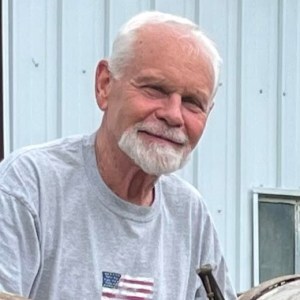 As of today, I live with an octogenarian. Yes, my Favorite Guy!
As of today, I live with an octogenarian. Yes, my Favorite Guy!
He grew up on a farm near Glidden, Iowa, and attended school in Glidden. We met at the State College of Iowa, where he was a business major. That meant that he’d be drafted upon graduation, so he enlisted in the Air Force. We were married the same year (1966).
The Air Force sent him to tech school for Air Traffic Control, to Mountain Home AFB, Idaho, then to Vietnam. Air Traffic Control became his career–in Colorado, then Des Moines, where he retired.
Guy has enjoyed robust health until the last few years, when he developed Parkinson’s, most likely for serving in Vietnam. He’s given up his motorcycle and sports car, and we’re unable to travel anymore. Enjoying the Iowa State Fair is in the past, but he still volunteers at church one day a week and has played trumpet with the local New Horizons Band for a dozen years.
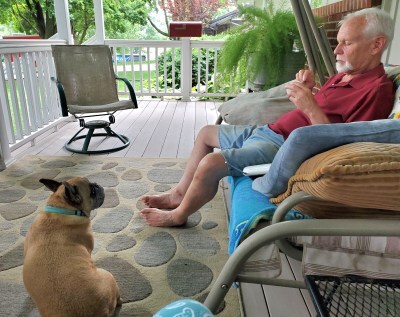 Neighbor Murphy waddles over to see if Guy might have a morsel for him.
Neighbor Murphy waddles over to see if Guy might have a morsel for him.He’s a popular neighbor, with his chainsaw, snowblower, and willingness to collect leaves every autumn. Now he enjoys watching the neighbors from his swing on the porch.
Happy Birthday from your Favorite Wife!
August 13, 2024
Misty Mountains Quilt
My shades-of-dusty-blue Misty Mountains quilt is a variation of the Thousand Pyramids design. You might have guessed that we had been reading J.R.R. Tolkien’s stories.
 The quilt is hand-pieced and hand-quilted by my quilting group (the Great Iowa Quilt Factory) in 1983. Elongated hearts are quilted in the lighter triangles. The backing is a printed fabric rather than plain.
The quilt is hand-pieced and hand-quilted by my quilting group (the Great Iowa Quilt Factory) in 1983. Elongated hearts are quilted in the lighter triangles. The backing is a printed fabric rather than plain.
Using some of the same fabrics, I made a miniature Schoolhouse quilt for a doll bed, and an even smaller Nine Patch with a Prairie Points border for fun. Well, it was fun back then!
The Misty Mountains quilt won a Blue Ribbon at the Iowa State Fair for a group quilt, was shown in the 1985 Invitational Quilt Show at the Des Moines Civic Center in conjunction with The Quilters musical.
In 1993, it was part of Quilt Extravaganza IV at Hoyt Sherman Place, which is on the National Register of Historic Places, in Des Moines.
August 8, 2024
Pete Springer’s Review of Leora’s Letters
“Clabe and Leora Wilson are salt-of-the-earth types, raising their family in rural Iowa as tenant farmers. Parents of ten children, three that died as young children, they tryAmeri to scratch out a living. Despite not having a lot of money, they possess an ability to work hard and raise a beautiful family. The story picks up when World War II is breaking out, and each of the remaining five boys want to join the service and represent their country.
“This true story is told from a series of family letters compiled by Clabe and Leora’s oldest grand[daughter], Joy. While Leora is one of the principal letter writers, their sons, daughters, and their spouses also exchange letters throughout the war. In order to not give away military secrets, the letters are censored before being sent home to Clabe and Leora.
“As each son departs, the others have to pick up the slack doing the farmwork. The family’s dream is for Clabe and Leora to eventually get a small house and piece of property of their own. The boys (young men) repeatedly send part of their paychecks home to help their parents realize their dream. Tragically, one of the boys goes missing after his plane goes down. The rest of the family is optimistic that he may be held as a POW and will eventually be able to come home at war’s end. The parents and kids continue to exchange letters as they attempt to lift each other’s spirits through life’s uncertainties.
“Through it all, Leora continues to push forward in her resilient manner and eventually Clabe and Leora are able to buy a place. Throughout the war, they hope that one day their entire family will be reunited again.
 “As if they hadn’t already experienced enough heartbreak, two other sons are killed while flying during the war. Despite some of the tragic events of this story, I would not describe this as a depressing book. It is more a reflection of the American spirit as the family perseveres despite their many hardships and tragedies.”
“As if they hadn’t already experienced enough heartbreak, two other sons are killed while flying during the war. Despite some of the tragic events of this story, I would not describe this as a depressing book. It is more a reflection of the American spirit as the family perseveres despite their many hardships and tragedies.”
Pete Springer
“I’m a retired elementary teacher (31 years) who will always be a strong advocate for children, education, and teachers. My favorite thing to do as a teacher was to read to my students, and now I’m following my heart and writing children’s books for middle grades.”
Thank you to Pete Springer for this kind review. You may get better acquainted with him through his website.
 Here’s a blurb, a short video, and reviews of Pete’s fascinating book about his decades of teaching, They Call Me Mom.
Here’s a blurb, a short video, and reviews of Pete’s fascinating book about his decades of teaching, They Call Me Mom.
August 6, 2024
Blog Tour for Simple Pleasures: Haiku from the Place Just Right by Elizabeth Gauffreau

The simple pleasures of our favorite places in nature are gifts of the spirit to be shared with others. In this collection of 53 haiku, each paired with a photograph, poet Liz Gauffreau invites readers to come with her to some of her favorite places in Vermont, New Hampshire, and Maine. Some places are long-time favorites going back years; others have become favorites by virtue of inspiring poetry.
For this blog tour stop, Liz provides some backstory for one of the places that appears in the book: Beaver Brook Falls in Colebrook, New Hampshire. (This backstory originally appeared on her family history blog in 2018.)
Beaver Brook Falls
 Beaver Brook Falls
Beaver Brook FallsA couple of weeks ago, I dragged my husband into an antique shop to see if I could find any antique or vintage postcards of places in New England associated with our families. I was
looking in particular for the hand-tinted ones because the colors aren’t quite natural, which gives the scene a proper feeling of otherworldliness.
The otherworldly scene I found was Beaver Brook Falls, which, for my brother George and me in the mid-1960s, was the real world of pounding water, slippery rock, and the smell of pine so intense we could reach out and grab it. As far as George and I were concerned, Beaver Brook Falls was one of the Seven Natural Wonders of the World.
 Location of Beaver Brook Falls
Location of Beaver Brook FallsThen one day we spied a couple of men standing in the water at the top of the falls. We were
transfixed. How had they gotten there? Had they entered the waterfall and climbed up some
natural stairway under the rushing water? No, our parents explained, there must be a path
alongside the falls, and the men had climbed up that way. From that day forward, every time
our parents took us for a picnic at Beaver Brook Falls, George and I begged to be allowed to
climb to the top of the falls. Our begging was to no avail.
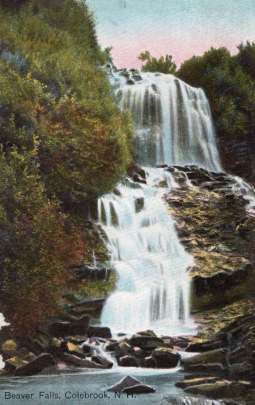 Beaver Brook Falls postcard
Beaver Brook Falls postcardGeorge and I grew up. Career and family took us out of New England. By the time I returned to New Hampshire after living many years in the South, over thirty years had passed. Nothing would do but I must return to Beaver Brook Falls and climb to the top. My husband didn’t think it was a particularly good idea, and it became less of a good idea when he saw how eroded the path was, but he went along. I later wrote the following poem about the experience (in a poetry slam workshop, of all places).
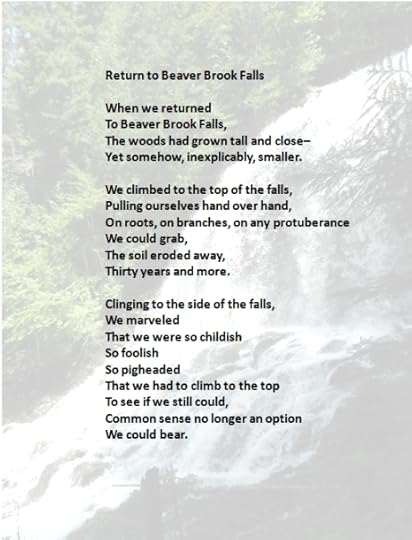
Fifteen more years went by, and I found the postcard of Beaver Brook Falls in the little antique shop in Concord. Back I went to the North Country to climb to the top of Beaver Brook Falls once again, this time with the admonitions of my husband dogging my footsteps and ringing in my ears, which I absolutely refused to heed. The haiku in Simple Pleasures captures the day’s folly.
 Made it!
Made it!‘Tis the gift to be simple, ’tis the gift to be free
‘Tis the gift to come down where I ought to be . . . .
~ Shaker song attributed to Joseph Brackett
Author Biography
 Elizabeth Gauffreau writes fiction and poetry with a strong connection to family and place. Her work has been widely published in literary magazines, as well as several themed anthologies. Her short story “Henrietta’s Saving Grace” was awarded the 2022 Ben Nyberg prize for fiction by Choeofpleirn Press.
Elizabeth Gauffreau writes fiction and poetry with a strong connection to family and place. Her work has been widely published in literary magazines, as well as several themed anthologies. Her short story “Henrietta’s Saving Grace” was awarded the 2022 Ben Nyberg prize for fiction by Choeofpleirn Press.
She has published a novel, Telling Sonny, and a collection of photopoetry, Grief Songs: Poems of Love & Remembrance. She is currently working on a novel, The Weight of Snow and Regret, based on the closing of the last poor farm in Vermont in 1968.
Liz’s professional background is in nontraditional higher education, including academic advising, classroom and online teaching, curriculum development, and program administration. She received the Granite State College Distinguished Faculty Award for Excellence in Teaching in 2018. Liz lives in Nottingham, New Hampshire with her husband. Find her online at https://lizgauffreau.com.
Book2Read Purchase Link: https://books2read.com/SimplePleasures
Print & Fixed EPUB for tablets and Kindle Fire
BookFunnel PDF Purchase Link: https://buy.bookfunnel.com/gef1ili6qd
For any device.
Blog Tour Host Links: https://lizgauffreau.com/simple-pleasures-blog-tour-links/
August 3, 2024
Crossed Off my Bucket List
There’s not a lot left on my bucket list that I’m physically able to do, but this one was a nice surprise.
Because Dad was the commander of a B-29 Superfortress the last months of WWII, I’d hoped to get to see (and hear) one land and/or take off. In 1991, the one named Fifi (the only airworthy B-29 at that point) was on display at the Mason City airport. After making sure when it was due to arrive, Mom, sis Gloria, and I drove up the day before so we could watch it land. It was already on the ground. What a disappointment.
We were the first in line the next morning. While chatting, it came up that I was doing some writing about WWII. The man in charge said, “I tell you what–if you want to come back up the day we leave, you can fly with us to Grand Rapids, but you’ll have to get your own ride home from there.”
I never did get a ride in the B-29, but all three of us did climb up into the cockpit for pictures in the commander’s seat.
 Mom in the commander’s seat, Mason City, Iowa, August 6, 1991
Mom in the commander’s seat, Mason City, Iowa, August 6, 1991 Me, Mom, Gloria–August 6, 1991, Mason City, Iowa
Me, Mom, Gloria–August 6, 1991, Mason City, IowaLast week we learned that old warbirds from the Commemorative Air Force would be at the Des Moines airport this week, including Fifi, and it would be giving rides–three on Saturday, two on Sunday.
Well, on the way to the airport today, my Favorite Guy and I watched Fifi fly across in front of us, to turn in to land. We were too late to watch that, but we hung around until we could see the old bomber fire up each of the four engines, one by one, then taxi to the runway. While we waited for takeoff, a P-51 roared off the runway, an T-6 Texan, and a PT-13 biwing plane.
Then here came the Superfortress down the runway, lifting, and quickly rumbling overhead. What a treat to get to see and hear this old warbird with connections to family history.
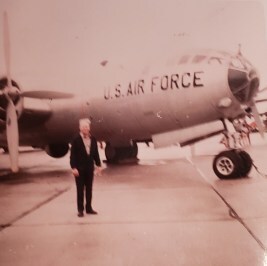 Dad next to a B-29, Offutt AFB, Nebraska, 1974
Dad next to a B-29, Offutt AFB, Nebraska, 1974Back in 1991, I tried to figure out how to make connections so I could ride in that B-29, but I needed someone to take me to Mason City and, the same day, someone to pick me up in Grand Rapids, MI. Mom couldn’t believe I’d even think about it. “That’s an old plane,” she reminded me, “and they’re already working on one of the engines.” Yes, but a B-29 has three more engines.
And if we crashed, I’d have a very interesting obituary, wouldn’t I?
August 2, 2024
Tramps and the Stuart Hotel
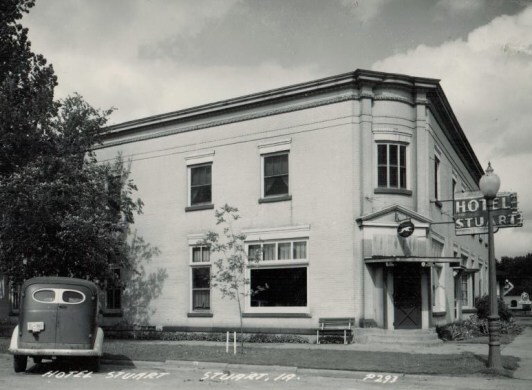
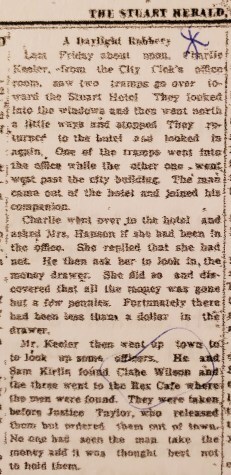 A Daylight Robbery
A Daylight Robbery
Last Friday about noon, Charlie Keeler from the City Clerk’s office room, saw two tramps go over toward the Stuart Hotel. They looked into the windows and then went north a little ways and stopped. They returned to the hotel and looked in again. One of the tramps went into the office while the other one went west past the city building. The man came out of the hotel and joined his companion.
Charlie went over to the hotel and asked Mrs. Hanson if she had been in the office. She replied that she had not. He then ask [sic] her to look in the money drawer. She did so and discovered that all the money was gone but a few pennies. Fortunately there had been less than a dollar in the drawer.
Mr. Keeler then went up town to look up some officers. He and Sam Kirlin found Clabe Wilson and the three went to the Rex Cafe where the men were found. They were taken before Justice Taylor, who released them but ordered them out of town. No one had seen the men take the money and it was thought best not to hold them.
From the August 4, 1922 Stuart Herald
 About 1915. To the right, across White Pole Road from the depot, is the Stuart Hotel.
About 1915. To the right, across White Pole Road from the depot, is the Stuart Hotel.You can see how close the hotel is to the depot. I wonder if Stuart had trouble with “tramps” often since they were right along While Pole Road and also the Rock Island Railroad.
My grandfather, Clabe Wilson, because the Stuart night watchman after Mr. Myers was killed during a bank robbery attempt.
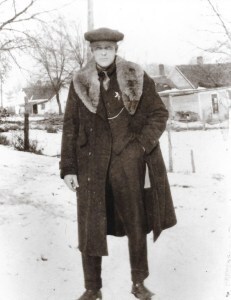
2024: The Stuart Hotel has been renovated and is looking for renters.
August 1, 2024
Dillon’s War, a new WWII book by Dennis Peterson
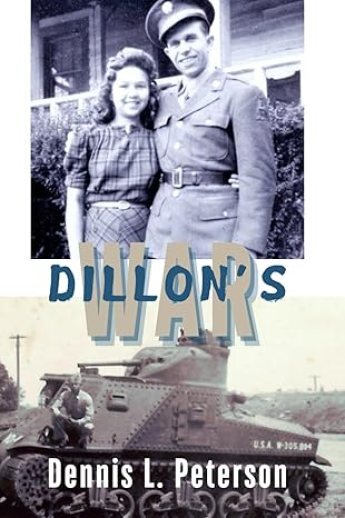 Dillon Summers, a driver for artillery forward observers of the 391st Armored Field Artillery Battalion, 3rd Armored Division, seldom talked about his experiences in World War II. Using several letters and V-mails that he wrote to his family members from England and the combat zone as well as his units’ histories, however, the author traces Dillon’s steps, detailing his experiences from induction through State-side training to embarkation for England and then his training on the Salisbury Plain.
Dillon Summers, a driver for artillery forward observers of the 391st Armored Field Artillery Battalion, 3rd Armored Division, seldom talked about his experiences in World War II. Using several letters and V-mails that he wrote to his family members from England and the combat zone as well as his units’ histories, however, the author traces Dillon’s steps, detailing his experiences from induction through State-side training to embarkation for England and then his training on the Salisbury Plain.
The book traces his steps from the breakout from the Normandy bocage during Operation COBRA, the chasing of the Germans from France and Belgium, and into Germany. It provides vivid descriptions of the battles in which he was engaged as a vital but too often unsung part at the tip of the spear that was the 3rd Armored Division.
My thoughts: A masterful story, woven from a handful of letters, a few family stories, and great research.
Dillon Summers’ actual combat with his unit began in late June 1944, when they landed on Omaha Beach. Historian Dennis Peterson gleaned details of battles from many sources and include memories of men who were there. These are especially valuable since Summers, who was the author’s uncle, didn’t talk about his extensive service in Europe and Germany.
Even though Summers was given a furlough to come home in early December 1944, the author continued to follow his unit. It’s hard to imagine having to return to that terrible war, although he was spared the Ardennes Campaign. Only eight letters from Summers during the war were saved, but they keep bringing the reader back to the human story of a young American who left family at home to help liberate Europe from Nazi tyranny.
He lived through terrible months and was awarded two Bronze Stars, then to witness the gruesome cruelty and inhumanity of one of the concentration camps after VE-Day. It’s a wonder he came home and lived a “normal life,” one remembered by a nephew who keeps his memory alive with this fine history.
 The Author: Dennis L. Peterson is an independent author, historian, and editor with numerous published credits in regional and national journals and magazines. A former history teacher and history curriculum writer, his areas of special interest include Southern history, the War Between the States, the Great Depression, and World War II. A native of East Tennessee, he now lives in Taylors, South Carolina.
The Author: Dennis L. Peterson is an independent author, historian, and editor with numerous published credits in regional and national journals and magazines. A former history teacher and history curriculum writer, his areas of special interest include Southern history, the War Between the States, the Great Depression, and World War II. A native of East Tennessee, he now lives in Taylors, South Carolina.
Here is Dennis’s Amazon Author page.
Please have a look at his website. The first thing you’ll notice is the compelling tales he’s shared on Our American Stories with Lee Habeeb.
July 30, 2024
Is Pinterest any fun?
I thought Pinterest was mostly for people who collected recipes and craft ideas. But when I joined an online writing group, the mentors shared all sorts of things to try out–from writing devotionals and blog posts to marketing and utilizing social media.
One author, who writes historical novels, showed us the large notebooks where she gathers information for future books. She also uses Pinterest when she finds photos similar how her heroine might look, what she might wear, where she could live, how she would travel, what would be in her local newspaper.
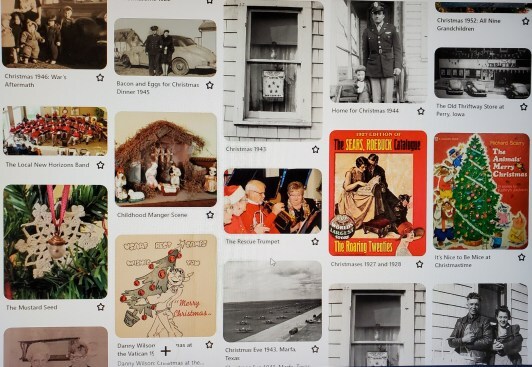 A few of the pins on the Christmas board
A few of the pins on the Christmas boardI tried it and it’s become very handy. Pinterest allows so many more categories (called “boards”) than this website does. Besides a WWII category, I’ve created “boards” for each Wilson brother, for each plane one of them flew, each ship one of them was assigned to. It’s visual and is the handiest place to find older stories.
Some fun boards: Cars, Christmas, Crafts, Country School, Early Ancestors, Faith, Guest Bloggers, Poems, Purple Heart, Quilts, Recipes, Steam Engines, Thanksgiving, and Tractors. My newest category is called Medical Stuff.
Take a look. You might enjoy exploring my Pinterest page, and you might just like to start one of your own. Yes, Pinterest is fun!
July 27, 2024
My First Quilt: Dresden Plate
 The iron bed is from the attic of the farmhouse my husband grew up in. Wedding photos of Clabe and Leora Wilson are in oval frames on the corner. Grandma Neal crocheted the doily under the ginger jar lamp. I made the small pillow, with GRANDMOTHER crocheting on it.
The iron bed is from the attic of the farmhouse my husband grew up in. Wedding photos of Clabe and Leora Wilson are in oval frames on the corner. Grandma Neal crocheted the doily under the ginger jar lamp. I made the small pillow, with GRANDMOTHER crocheting on it.Even though Grandma Ruby Neal and her daughters quilted since the Dark Ages, I never tried it even though I did a lot of sewing, especially after joining 4-H. Mom sewed but she didn’t quilt.
So I didn’t made my first quilt until Guy was stationed at Mountain Home AFB, Idaho. I joined a group of women, about half military wives, half locals. June Elliott and Margie Savala got me started with the pattern, a variation of Dresden Plate, and neighbor Ethyl Baldwin also helped. They all must have contributed scraps of fabric for the project.
All stitched by hand, Mountain Home, Idaho, 1968. 70 ” x 94″

July 25, 2024
Fascinating Family History by Allen E. Rizzi
I’ve enjoyed a couple of Allen Rizzi’s stories from his fascinating family history. The Immigrant is his latest one:
The Immigrant
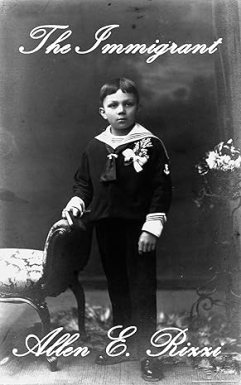 The Immigrant
traces the life of a bold 20th century immigrant. From humble beginnings in pre-World War I Austria, he lived through a rapidly changing world, adapting to what needed to be done to contribute to America and above all honor his commitment to family. Richly detailed with antique photographs, this story paints a portrait of immigration at its best in stark contrast to many of today’s immigrants...
The Immigrant
traces the life of a bold 20th century immigrant. From humble beginnings in pre-World War I Austria, he lived through a rapidly changing world, adapting to what needed to be done to contribute to America and above all honor his commitment to family. Richly detailed with antique photographs, this story paints a portrait of immigration at its best in stark contrast to many of today’s immigrants...
My Thoughts: What a compelling life story of a man who immigrated to the US as a child. A child prodigy on the violin, he returned to Europe to study, leaving his mother and brothers in the US. By then, the Great Depression had begun so jobs were scarce. He adapted time after time having surprising jobs in Hollywood, he served in the Signal Corps during WWII, and one of his hobbies eventually led to an amazing contribution to salmon fishing in Oregon. What a legacy!
The Horse Whisperers from Anaconda
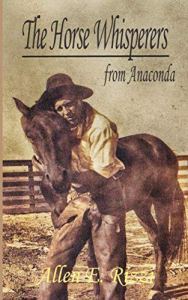 The Horse Whisperers from Anaconda chronicles the lives of horse whisperer brothers Lee and Edd Allen. Born in Pike County, Missouri and raised in Anaconda, Montana, the two became admired in their youth as they followed the teachings and traditions of their family and Blackfoot Indian friends to help build the American West. Richly illustrated with antique photographs, this novella explores the art of horse whispering as applied to everyday life and the grit that polished America into the gem it is today.
The Horse Whisperers from Anaconda chronicles the lives of horse whisperer brothers Lee and Edd Allen. Born in Pike County, Missouri and raised in Anaconda, Montana, the two became admired in their youth as they followed the teachings and traditions of their family and Blackfoot Indian friends to help build the American West. Richly illustrated with antique photographs, this novella explores the art of horse whispering as applied to everyday life and the grit that polished America into the gem it is today.
My thoughts: This is a corner of history that was new to me–a family moving from Missouri to the wilds of Montana to oversee a timber operation, but the sons learning training horses from Blackfoot Indians, which turned into jobs. They also trained horses for the army during WWI. They were hunters and mountainmen. Leather items they made still survive among descendants.
Lee and Edd Allen’s interests were so different. Lee stayed with their parents when they moved to California, still cherishing the outdoors. Edd was an artist, illustrator, printmaker, and lived in Paris for a time. One etching is in the Smithsonian, and others have become popular to collect–under his birth name of James E. Allen. A great tribute to the author’s ancestors and relatives.
The Author
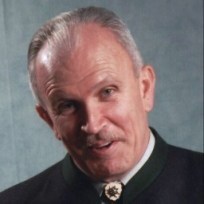 Writer with over 55 years professional experience including non-fiction, biography, music, poetry and corporate analytic writing. Additional expertise as a photographer, historical researcher and genealogist. Specialties: Historical non-fiction, nostalgia, public profiles, biographies, and documentary writing in English, Italian, and German. Music composition and lyrics: Author of over 200 songs from 1974 to present.
Writer with over 55 years professional experience including non-fiction, biography, music, poetry and corporate analytic writing. Additional expertise as a photographer, historical researcher and genealogist. Specialties: Historical non-fiction, nostalgia, public profiles, biographies, and documentary writing in English, Italian, and German. Music composition and lyrics: Author of over 200 songs from 1974 to present.
Here is Allen’s Amazon Author Page. Please also have a look at his website.



